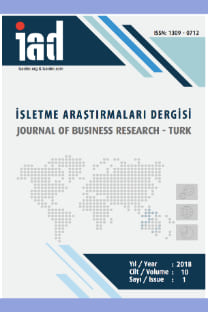İşyerindeki Dışlanmanın, İşyerindeki Sapkın Davranışlar Üzerindeki Etkisi: Personelin Düzenleyici Odağının Rolü
The Influence of Workplace Exclusion on Workplace Deviance Behaviors: The Role of Employees’ Regulatory Focus
___
- Baron, Reuven. M. ve Kenny, David A. (1986). The moderator-mediator variable distinction in social psychological research: Conceptual, strategic, and statistical considerations, Journal of Personality and Social Psychology, 51, 1173-1182.
- Baumeister, Roy F., Dewall, C. Nathan, Ciarocco, Natalie J. ve Twenge, Jean M. (2005). Social exclusion impairs self-regulation, Journal of Personality and Social Psychology, 88, 589-604.
- Braas Daniel J. ve Scott Kristin D. (2007). The development and test of an exchange-based model of interpersonal workplace exclusion, Doctorate Thesis, University of Kentucky.
- Brenninkmeijer, V., Demerouti, E., Blanc, Le, Pascale M., ve Emmerik, Van, I. J. Hetty (2010). Regulatory focus at work: The moderating role of regulatory focus in the job demands-resources model, Career Development International, 15, 708-728.
- Brown, Michael E. ve Trevino, Linda K. (2006). Socialized charismatic leadership, values congruence, and deviance in work groups, Journal of Applied Psychology, 91, 954-962.
- Dunlop, Patrick D. ve Lee, K. (2004). Workplace deviance, organizational citizenship behavior, and business unit performance: The bad apples do spoil the whole barrel, Journal of Organizational Behavior, 25, 67- 80.
- Elsamen, A. A. (2011). Examining the construct validity of the lockwood goal orientation scale using the general hierarchal model: An exploratory study, Journal of Management Policy and Practice, 12(4), 81-92.
- Hitlan, Robert T., Cliffton, Rebecca J. ve Desoto, M. Catherine (2006). Perceived exclusion in the workplace: The moderating effects of gender on work-related attitudes and psychological health, North American Journal of Psychology, 8, 217-235.
- Hitlan, Robert T. ve Noel, J. (2009). The influence of workplace exclusion and personality on counterproductive work behaviours: An interactionist perspective, European Journal of Work and Organizational Psychology, 18, 477-502.
- Huffman, K. (1994). Psychology in Action, Canada: John Wiley.
- Oyserman D., Uskul A. K., N. Yoder, Randy M. Nesse ve D. R. Williams. (2007). Unfair treatment and selfregulatory focus, Journal of Experimental Social Psychology, 43, 505–512.
- Raelin, Joseph A. (1994). Three scales of professional deviance within organizations, Journal of Organizational Behavior, 15, 483-501.
- Robinson, Sandra L. ve Bennett, Rebecca J. (1995). A typology of deviant workplace behaviors: A multidimensional scaling study, Academy of Management Journal, 38, 555-72.
- Scott, K. D. ve Brass, Daniel J. (2007). The development and test of an exchange-based model of interpersonal workplace exclusion, Doctorate Thesis, University of Kentucky.
- Uskul A. K., Sherman David K. ve Fitzgibbon, J. (2009). The cultural congruency effect: Culture, regulatory focus, and the effectiveness of gain- vs. loss-framed health messages, Journal of Experimental Social Psychology, 45, 535-541.
- Witt, L. A. ve Andrews, Martha C. (2006). The predisposition to engage in interpersonal deviance at work, Academy of Management Annual Meeting Proceedings, 1-6.
- Wu, C., Mcmullen, J. S., Neubert, Mitchell J., ve YI, Xiang (2008). The influence of leader regulatory focus on employee creativity, Journal of Business Venturing, 23, 587-602.
- Yperen, Nico W. V. (2003). On the link between different combinations of negative affectivity and positive affectivity and job performance, Personality and Individual Differences, 35, 1873-1881.
- ISSN: 1309-0712
- Yayın Aralığı: 4
- Başlangıç: 2009
- Yayıncı: Melih Topaloğlu
Fault Detection in Manufacturing Companies with Ensemble Machine Learning Method
Semra BORAN, Deniz DEMIRCIOGLU DIREN
Sağlık Kurumlarında Çalışan Hemşirelerin Tükenmişlik Algılarının İşten Ayrılma Niyetlerine Etkisi
Oktay EMİR, Engin BAYRAKTAROĞLU
Mustafa CANBEK, Mehmet Ali İPEK
Şeyda Nur SEÇKİN, Mehmet TİKİCİ
Bitcoin İçin Volatilite Tahmini: Simetrik ve Asimetrik Garch Modelleri İçin Ampirik Bir Uygulama
Gülfen TUNA, Ahmet Bülent ATASOY
The Impact of Corporate Strategies on Financial Leverage: Evidence From TurkishListed Firms
Burcu DİNÇERGÖK, Ahmed Ibrahim Abdelhadi HOUR
Determining the Factors Affecting Liquidity Risk in Insurance Companies: Borsa İstanbul Example
